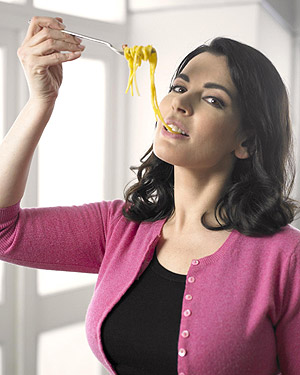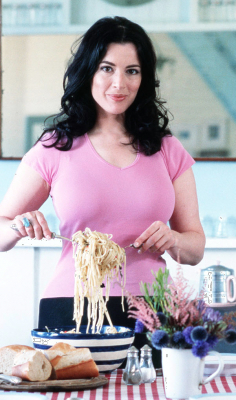
So asks Laura Day in the U.K. Guardian’s Word of Mouth blog in yet another take on the food safety silliness on many TV cooking shows.
Over recent weeks, MasterChef has been pushing contestants through their "toughest challenge yet" (again), which seems to have led to competition-induced amnesia when it comes to basic standards.
"Former Miss Swansea" Alice has been sporting a shock of bright red nail polish before she rustles up the goods. She’s taken some flak from viewers online for kneading dough with her chipped nails, with suspicions that some of the polish made it into her miniature lasagnes.
Compulsive hair grabber Polly has attracted ire for her flyaway strands (she should take a cue from bandana-wearing Jackie), and then there are the men, arguably the clammier end of the .jpeg) spectrum, who persist in adding many beads of sweat to their pan-fried cuisines. Not to mention Tom, who consistently creates an epic mess, and this week drew quite the dressing down from John who offered a disparaging shake of the head towards the floured floor at his feet.
spectrum, who persist in adding many beads of sweat to their pan-fried cuisines. Not to mention Tom, who consistently creates an epic mess, and this week drew quite the dressing down from John who offered a disparaging shake of the head towards the floured floor at his feet.
This is the kind of behaviour we would more commonly associate with the string of cooks on Come Dine With Me, whose contestants are often to be found scraping crème brûlée off the lino and leaving sushi unguarded to be snacked on by their cat. But it’s not just the amateurs, and it’s not just recently.
Pudding-fiend and glamour puss Nigella, all boobs and spoon-licking, has always had her hair perfectly coiffed. Sure, her luscious locks look pretty good flowing all over her shoulders (and who wouldn’t want a head of hair like that?), I just wouldn’t want to admire it in my plate of brownies.
We covered this ground years ago, and while I’d like to redo the study, Food Network ratings have recently flattened, so maybe people are doing less watching and more cooking Thanks to Bobby Krishna in Dubai for sending along the story.
Mathiasen, L.A., Chapman, B.J., Lacroix, B.J. and Powell, D.A. 2004. Spot the mistake: Television cooking shows as a source of food safety information, Food Protection Trends 24(5): 328-334.
Consumers receive information on food preparation from a variety of sources. Numerous studies conducted over the past six years demonstrate that television is one of the primary sources for North Americans. This research reports on an examination and categorization of messages that television food and cooking programs provide to viewers about preparing food safely. During June 2002 and 2003, television food and cooking programs were recorded and reviewed, using a defined list of food safety practices based on criteria established by Food Safety Network researchers. Most surveyed programs were shown on Food Network Canada, a specialty cable channel. On average, 30 percent of the programs viewed were produced in Canada, with the remainder produced in the United States or United Kingdom. Sixty hours of content analysis revealed that the programs contained a total of 916 poor food-handling incidents. When negative food handling behaviors were compared to positive food handling behaviors, it was found that for each positive food handling behavior observed, 13 negative behaviors were observed. Common food safety errors included a lack of hand washing, cross-contamination and time-temperature violations. While television food and cooking programs are an entertainment source, there is an opportunity to improve their content so as to promote safe food handling.
.jpeg)

 n a standard food porn piece,
n a standard food porn piece, .jpg) “This is not about currying favor, it is about developing a relationship. In this business, it’s about the handshake — looking them in the eye.”
“This is not about currying favor, it is about developing a relationship. In this business, it’s about the handshake — looking them in the eye.”  My father was the inspiration for our 2004
My father was the inspiration for our 2004